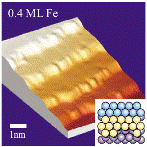Department of Physics and Astronomy: Publications and Other Research

Axel Enders Publications
Document Type
Article
Date of this Version
2002
Abstract
The structure of (C60) n clusters (n = 1– 150) was investigated by heating them to definite temperatures in a helium bath (heating cell) with subsequent characterization in a time-of-flight mass spectrometer. The intensity anomalies in the resulting mass spectra reflect particularly stable configurations that resisted evaporation. However, the set of enhanced peaks (magic numbers) turned out to be temperature dependent. Clusters heated to a moderate temperature of 490 K yielded mass spectra indicating the presence of icosahedral structures that can be characterized by a set of unusually strong peaks, namely n = 13, 19, 23, 26, 35, 39, 43, 46, 49, 55, 55 + 3m, 116, 125, 131, 137, and 147 (m = 1– 14). Based on constant-temperature molecular dynamics simulations it could be concluded that these icosahedra represent metastable structures that had not yet attained thermal equilibrium on the experimental time scale (ts = 0.5 ms). Only when the (C60) n clusters were heated to appreciably higher temperatures they could reach thermodynamical equilibrium, manifested by a thermally induced structural transition into close-packed structures, decahedral structures and structures based on the 98-Leary tetrahedron. Thus, mass spectra of clusters heated to 600 K demonstrate the new set of magic numbers, n = 38, 48, 58, 61, 64, 68, 71, 75, 77, 84, 89, 91, 96, and 98. Additionally, the experimental arrangement used allows both charged and neutral (C60) n clusters to be studied. Thereby, it was possible to show that the structure of large (C60) n clusters is insensitive to their charge state (-/n/+), disproving a hypothesis that has been discussed in the literature for several years. The heating cell was also used to study the thermally induced dissociation in the fullerene dimers (C60) 2, (C70) 2, and (C60) 2+ . The dissociation energies were determined to be 0.275 eV, 0.313 eV, and 0.37 eV, respectively (±0.08 eV).


Comments
Published in PHYSICAL REVIEW B 66, 094107 (2002); DOI: 10.1103/PhysRevB.66.094107 ©2002 The American Physical Society. Used by permission.